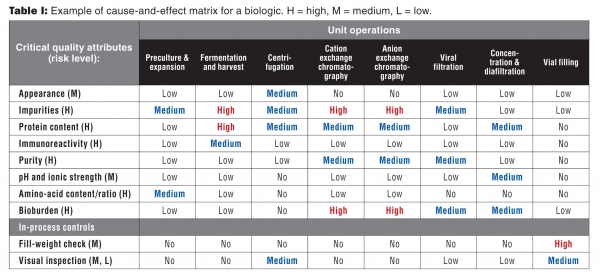Cause-and-effect matrix
Once risk levels have been assigned to the CQAs, the next activity is to begin to relate which parts of the process have impact on these attributes. This cause-and-effect analysis breaks the process into its unit operations and conveys its impact on the CQAs. An example of the cause-and-effect matrix for a biologic is given in Table I.
Table I: Example of cause and effect matrix for a biologic. H = high, M = medium, L = low.

In addition to the matrix, it is important to document the justification for these decisions as part of this analysis. For example, the parameters of the cation- and anion-exchange chromatography processes are expected to have a high impact on impurities because they are designed to remove impurities of different ionic charge than the desired product. With the knowledge of which unit operations have impact on particular CQAs, it is now possible to analyze each process’ inputs and outputs to determine how process parameters affect the CQAs.
Input and output process variables
Each unit operation has both input and output process variables. Process parameters signify process inputs that are directly controllable and can theoretically impact CQAs. Process outputs that are not directly controllable are attributes. When the attribute ensures product quality, it is a CQA. The output of one unit operation can also be the input of the next unit operation. These parameters and attribute designations and their justification should be documented in either a formal process description document, or process flow diagram/drawing. This documentation should also include the scale of each unit operation, equipment and materials required, sampling/monitoring points, test methods, and relevant processing times and storage times/conditions.
The intent of assessing process parameters is to determine how they affect the process variation of CQAs along with their control strategy. Each company should clearly document their methodology for defining and assessing parameters. The following may be considered in making that assessment:
• Raw material attributes are outputs of the release of materials. Critical material attributes (CMA) should be considered along with CPPs as impacting process variability.
• Fixed parameters such as equipment scale, equipment setup, pre-programmed recipes should be documented but are assessed as either low or non-critical.
• Parameters for sterilization processes and cleaning process and the preparation of process intermediates can be included in the primary process assessment. Alternatively, they can be treated as independent processes with their own process parameters, quality attributes, criticality assessments, and process validation.
• Calibration and standardization setting for equipment and instruments are usually not included as process parameters.
• Formulation recipes can be considered fixed parameters (low or not critical); these parameters generally have relatively tight limits, which are justified during formulation development. Such a parameter, which does not vary, cannot impact process variability. An exception to this rule is the case where operators must calculate a quantity based on a variable input such as biological activity; this variable process parameter may lead to process variation.
• Holding/storage times and conditions where no processing occurs should be qualified to show little to no impact on the product. These should be documented and, if these factors are included as process parameters, they are considered low or non-critical.
• Environmental conditions during process (room temperature, humidity), such as holding times, are to have set limits so that they have little to no impact to the process. Process-specific environmental conditions such as cleanrooms, cold rooms, and dry rooms are included as process parameters because they are monitored to ensure product quality.
When a process parameter is determined to be non-critical either by process knowledge or by process study, companies may choose to further designate the parameter as a key performance parameter if that parameter impacts a process performance attribute